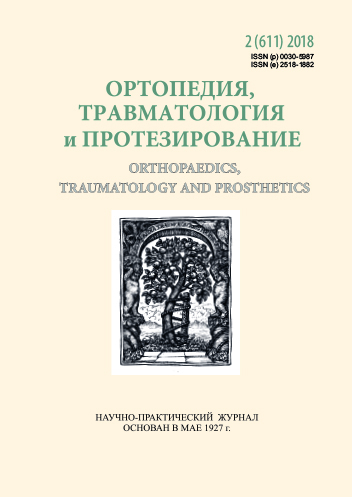Surgical treatment of patients with ankle joint fracture and damage of syndesmosis
DOI:
https://doi.org/10.15674/0030-59872018263-67Keywords:
ankle fractures, syndesmosis, tight loops, surgical traumatologyAbstract
Treatment of unstable ankle joint fractures with damage of syndesmosis is one of important problems in modern traumatology practice.
Objective: to evaluate the results of surgical treatment of patients with ankle joint fractures and damage of syndesmosis due to analysis of functional ankle state and assessment of life quality in postoperative period.
Methods: we analyzed the results of surgeries of 80 patients (18–67 y. o.) with ankle joint fracture and damage of syndesmosis. In all cases we made osteosynthesis and restoring of syndesmosis stability with following course of rehabilitation, which was the same in our groups. In the main group 44 patients we used developed devices (modeling plates with polyaxial screws blocking for external malleous and tight loops for syndesmosis stabilization). In comparative group (36 patients) we used method АО/ASIF (for external malleous we used AO ⅓ and 1–2 cortical screws of 3.5 mm for syndesmosis fixation). We assessed the results of treatment in 3, 6, 12 months after surgery with 100 score Ankle-Hindfoot Scale AOFAS and SF-36 system.
Results: it was established that in the early terms after surgery (3 mon.) in the main group the functional results were better according to AOFAS scale on 17 %. The quality of life according to SF-36 was also better: the signs of physical condition — 21 %, psychological — 7.4 %.
Conclusions: suggested method combines stable osteosynthesis of external malleous fractures with stable dynamic fixation of syndesmosis, it allow in improve the life quality and to get excellent and good results in 95.5 % cases.References
- Kaye, J. A., & Jick, H. (2004). Epidemiology of lower limb fractures in general practice in the United Kingdom. Injury Prevention, 10(6), 368–374. doi: https://doi.org/10.1136/ip.2004.005843
- Grygorieva, N., Vayda, V., Vlasenko, R., & Zubach, O. (2016). Epidemiology of lower limb fractures in Ukrainian population. Osteoporosis International, 27(1 Suppl. 1), S509.
- Zhang, P., Liang, Y., He, J., Fang, Y., Chen, P., & Wang, J. (2017). A systematic review of suture-button versus syndesmotic screw in the treatment of distal tibiofibular syndesmosis injury. BMC Musculoskeletal Disorders, 18(1). doi: https://doi.org/10.1186/s12891-017-1645-7
- Van den Bekerom, M. P., Kloen, P., Luitse, J. S., & Raaymakers, E. L. (2013). Complications of distal tibiofibular syndesmotic screw stabilization: Analysis of 236 patients The Journal of Foot and Ankle Surgery, 52(4), 456-459. doi: https://doi.org/10.1053/j.jfas.2013.03.025
- Segal, G., Elbaz, A., Parsi, A., Heller, Z., Palmanovich, E., Nyska, M., … & Kish, B. (2014). Clinical outcomes following ankle fracture: a cross-sectional observational study. Journal of Foot and Ankle Research, 7(1). doi: https://doi.org/10.1186/s13047-014-0050-9
- Schatzker, J., & Tile, M. (2017). The Rationale of Operative Fracture Care (pp. 551–590). Berlin/Heidelberg: Springer-Verlag.
- Miller, A. N., Paul, O., Boraiah, S., Parker, R. J., Helfet, D. L., & Lorich, D. G. (2010). Functional outcomes after syndesmotic screw fixation and removal. Journal of Orthopaedic Trauma, 24(1), 12-16. doi: https://doi.org/10.1097/bot.0b013e3181c6e199
- Kaftandziev, I., Spasov, M., Trpeski, S., Zafirova-Ivanovska, B., & Bakota, B. (2015). Fate of the syndesmotic screw—Search for a prudent solution. Injury, 46, S125-S129. doi: https://doi.org/10.1016/j.injury.2015.10.062
- Olsen, J. R., Hunter, J., Olsen, J. R., & Baumhauer, J. F. (2013) Osteoporotic ankle fracture. Orthopedic Clinics of North America, 44(2), 225–241. doi: https://doi.org/10.1016/j.ocl.2013.01.010
- McKean, J., Cuellar, D. O., Hak, D., & Mauffrey, C. (2013). Osteoporotic ankle fractures: an approach to operative management. Orthopedics, 36(12), 936-940. doi: https://doi.org/10.3928/01477447-20131120-07
- Golovakha, M. L., Kozhemyaka, М. А., & Maslennikov, S. O. (2016). Evaluation of the results of surgical treatment of ankle fractures with the tibiofibular syndesmosis injury. Zaporozhye Medical Journal, 0(6). doi: https://doi.org/10.14739/2310-1210.2016.6.85529
- Marsh, J. L., Slongo, T. F., Agel, J., Broderick, J. S., Creevey, W., DeCoster, T. A., … Audigé, L. (2007). Fracture and dislocation classification compendium - 2007. Journal of Orthopaedic Trauma, 21(Supplement), S1-S6. doi: https://doi.org/10.1097/00005131-200711101-00001
- Kitaoka, H. B., Alexander, I. J., Adelaar, R. S., Nunley, J. A., Myerson, M. S., & Sanders, M. (1994). Clinical rating systems for the ankle-hindfoot, midfoot, hallux, and lesser toes. Foot & Ankle International, 15(7), 349-353. doi: https://doi.org/10.1177/107110079401500701
- Ware, J. E., & Sherbourne, C. D. (1992). The MOS 36-ltem short-form health survey (SF-36). Medical Care, 30(6), 473-483. doi: https://doi.org/10.1097/00005650-199206000-00002
Downloads
How to Cite
Issue
Section
License
Copyright (c) 2018 Maksym Kozhemyaka, Maksym Golovaha

This work is licensed under a Creative Commons Attribution 4.0 International License.
The authors retain the right of authorship of their manuscript and pass the journal the right of the first publication of this article, which automatically become available from the date of publication under the terms of Creative Commons Attribution License, which allows others to freely distribute the published manuscript with mandatory linking to authors of the original research and the first publication of this one in this journal.
Authors have the right to enter into a separate supplemental agreement on the additional non-exclusive distribution of manuscript in the form in which it was published by the journal (i.e. to put work in electronic storage of an institution or publish as a part of the book) while maintaining the reference to the first publication of the manuscript in this journal.
The editorial policy of the journal allows authors and encourages manuscript accommodation online (i.e. in storage of an institution or on the personal websites) as before submission of the manuscript to the editorial office, and during its editorial processing because it contributes to productive scientific discussion and positively affects the efficiency and dynamics of the published manuscript citation (see The Effect of Open Access).














